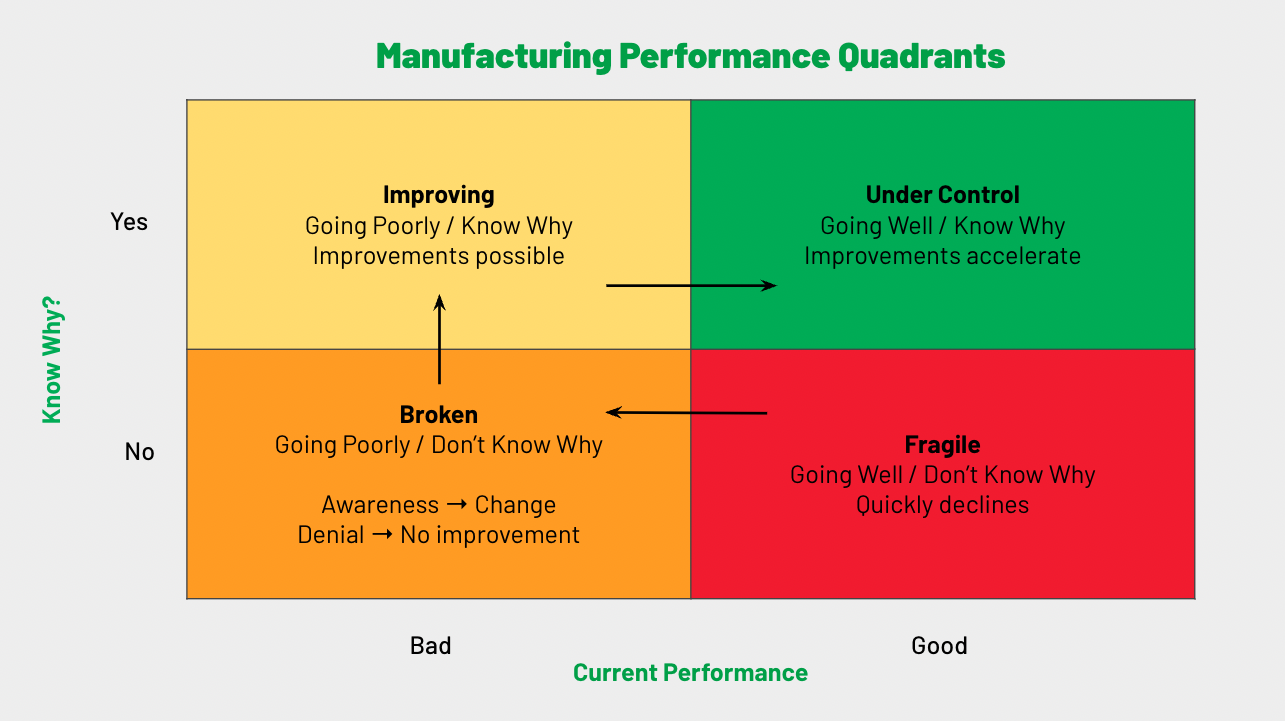Former Tesla operations leader explains why manufacturing performance and manufacturing capability requires more than just being problem-free
Greg Reichow doesn’t mince words when he talks about a major challenge in manufacturing: “I’ve been shocked at how poor problem-solving is in most places.” Now a General Partner at Eclipse Ventures, Greg was a vice president in operations and production at Tesla for over five years, following a successful career in various manufacturing and quality roles. He has witnessed good and bad examples of production floor problem-solving and is on a mission to fix it. Greg is an advocate for smart assessment of manufacturing process capability, including the team in that process, and helps teams and companies determine the health of their program using a simple framework: the Manufacturing Performance Quadrant.
Using the Manufacturing Performance Quadrant to solve manufacturing problems
Greg believes this problem-solving quadrant is applicable to any vertical, but is especially relevant in electronics manufacturing.
“In electronics manufacturing, you’re building small things that you can’t see with the naked eye,” Greg said. “Incredible precision is required to build billions of transistors on a single computer chip, which means two things: hundreds of things can go wrong, and teams end up looking the other way when things are going well.”
This philosophy is the foundation of a pervasive myth in manufacturing — that things are under control when things are going well. It doesn’t. The Manufacturing Performance Quadrant explains why.
The Manufacturing Performance Quadrant
First, here is a brief review of each part of the quadrant.
Under Control: A state of success
This stage is in the upper right corner, in green. Teams with programs in this stage not only deliver quality products and meet yield targets, but also know exactly why the program is running smoothly. This is where continuous improvements can happen. The challenge is to get there and stay there.
Improving: A state of potential
This stage is in the upper left corner, in yellow. Programs in this stage are failing in some way — but the team knows why. Maybe a known design flaw is causing failures, or a component from an upstream supplier isn’t meeting quality standards. But in this stage, teams know the problem, making improvements possible.
Broken: A state of disorder
This stage is in the lower left corner, in orange. Programs in this stage are broken because things aren’t going well, and teams don’t know why. This can lead to two possible outcomes: if teams admit things are broken, they could move to the “improving” stage, because they know there’s a problem. If they’re in denial, however, improvement is no longer an option, which could lead to permanent failures down the road.
Fragile: A state of danger
This stage is in the lower right corner, in red. Programs in this stage are running smoothly — but teams don’t know why. It’s the most dangerous part of the quadrant because on the surface, it looks “under control.” In reality, a lack of knowledge could cause a rapid and sudden decline into “broken.”
The risk of confirmation bias
Greg believes that understanding the status of your program within this framework is the first step to change. But there’s a hurdle that can prevent necessary action: confirmation bias. Confirmation bias causes team members to believe they’re in one quadrant, when in reality they’re in another.
At one point, Tesla was developing a new drive unit for the Model S that would improve performance and range. They also wanted to make it quieter. So, the team decided to first focus on building a more efficient motor, with plans to address the issue of noise later in the process.
“This happens a lot in engineering,” said Greg. “You focus on solving for one set of parameters, and you end up writing off problems that are already lurking, thinking, ‘I’m smart, I know that’s going on, and it won’t be an issue later.’ You don’t want to believe that it’s a problem.”
Unfortunately, while working in this “fragile” state, the noise problem they hadn’t addressed became a big concern. After more than a year of development, and on the eve of the launch, Elon Musk took the car for a test drive and, in Greg’s words, was “disgusted” at the noise coming from the drive unit. The Tesla team later found the solution with better mounts and insulation — but it required expensive repairs and delayed the release.
“It goes to show that it’s important to have the unvarnished truth about how things are performing as early as possible,” said Greg.
Applying the Manufacturing Performance Quadrant to leadership
Just as manufacturing teams can use the Manufacturing Performance Quadrant to measure the health of their programs, leaders can use it to assess the health of their teams and build a team culture.
“If you’re in a meeting and someone is describing a really ugly problem, your first reaction won’t be filled with anxiety or dread. It will be, ‘Great! This person has found a problem, now we can fix it!’” Greg said. “The quadrant can help leaders see that identifying problems is really identifying opportunity.”
Related Topics




